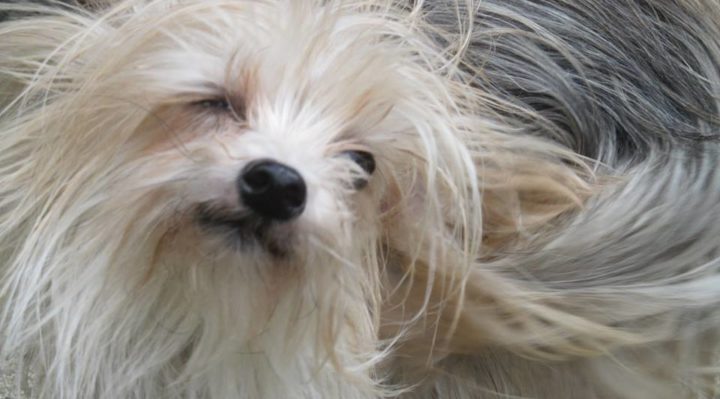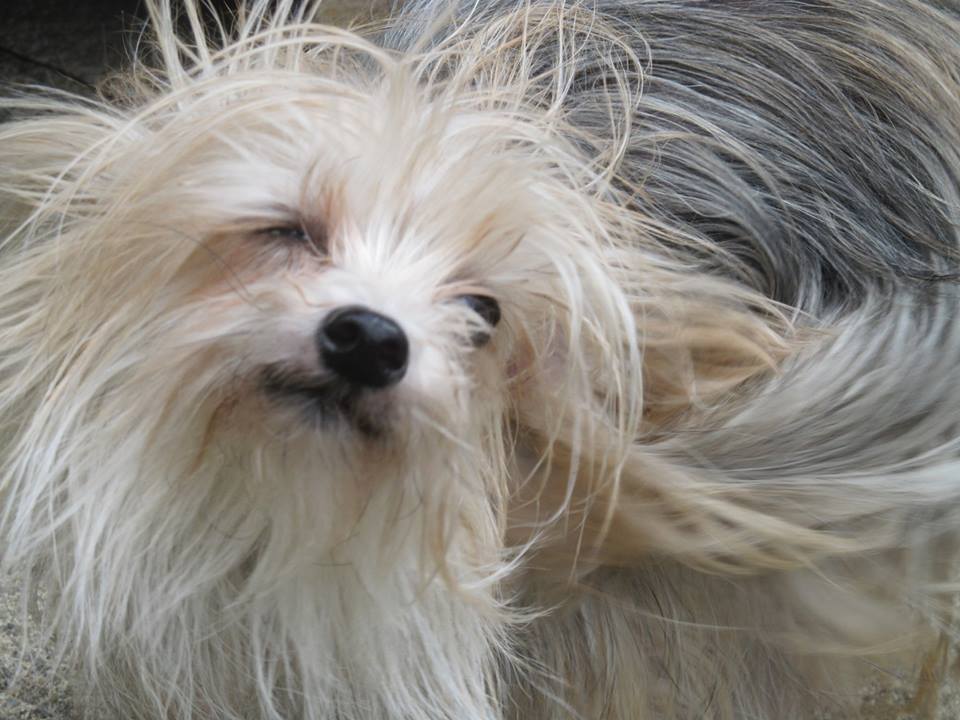
Last week, I introduced you to a dog I rescued in four lanes of traffic on a nearby street.
This week, I’ll tell you how we’re coping with some issues that have arisen as she ages.
She weighs five pounds.
She’s 18 years old.
I never expected that any dog would live this long!
She’s healthy, aside from a little stiffness when she first gets up.
She’s losing sight and hearing, but neither are completely gone.
I want her to be happy and relatively healthy as long as possible!
I share in this article some suggestions on what works for us.
Grooming
Her long, straight fur has always been a grooming challenge. When she first joined our family, I took her to a wonderful, experienced, gentle groomer who really knew what she was doing. My dog learned not to fear grooming and bathing, although I can’t say she’s ever been exactly enthusiastic about it! I learned the techniques that would work best on her. The groomer suggested that I leave the fur long, not trim it shorter like a Yorkie’s. “Let her be who she is,” the groomer said. I agreed.
In the last year, it’s become more and more difficult to keep her well groomed. She’s lost her spit, it seems!
I had a long-haired cat who lived to 22 and lost his ability to keep up with his own grooming as he aged. He matted horribly. It was either comb him daily or cut the mats out almost as often.
My dog’s fur is longer, if not nearly as thick as that cat’s—and hers weaves itself into long, tangled strands overnight. It hurts her when I try to comb the strands out, so now I trim instead. Her skin shows through the shorter fur, but at least that skin is healthy. It’s not a look that either of us would choose, but it’s painless for her. At this point, what other choice can I make? Also . . .
▪ More frequent, shorter baths
▪ Gentle shampoo, conditioner
▪ Safe, non-slip bathing setup
▪ Groom well before bathing
▪ Nail trimming after bathing
▪ Dry off in a nice warm room
▪ Brush out once the fur is dry

Photo by Val Hughes
Elimination
She’s always been a camel: she rarely drinks water except in warm weather and she’s traditionally gone out to potty just twice a day—first thing in the morning and after dinner in the evening. That was all she needed. She learned early as a resident here to “go” whenever she was put outside.
I’m proud that she learned, too, with my help, to potty on cue, always just before a rehearsal or performance at the theater, even though those elimination excursions were way off her regular schedule. She knows how to “ask” to go out at home, as well. Her “out” request involves getting my attention, of course. That is a much more difficult task when you’re only five pounds of dog!
Now, it seems, she simply has to “go” more often—four times a day, this month—so I mark the times mentally and, if I remember, there are no accidents. I don’t wait for her to ask, I keep to a schedule. She does ask, still, and I take her out then, too. She’s always willing to “go” when she gets outside! She’s allowed on my bed, as usual, when I can guarantee she’s “empty,” and she’s crated overnight and when I’m away from home, to contain any possible accidents for quick cleanup.
This winter, she will have difficulty with the snow and ice. There’s only so much I can do to make it easier and more comfortable for her. I’m considering using potty pads on the screened porch. She’s never used potty pads, but I think she can learn. I can certainly learn, at least, how to get the potty pads more or less under her rear end just when she’s about to squat. We’ll see how it goes!
Off the menu, to avoid digestive incidents or surprise diarrhea, are any foods, for dogs or humans, that might upset her system. I instituted that rule—for the rest of her life—after I very unwisely allowed her to eat a nacho chip covered with “liquid cheese” from a cheap taco meal. Those few morsels led to a week of discomfort and unhappiness for her . . . and enormous guilt for me. I can’t expect her aging gut to accept the assaults of food she’s not used to, as it did in her youth!
Safety
I must watch where I walk!
She’s tiny. Her fur camouflages her further, as neutral a mix of colors as you can get. She can disappear against the kitchen floor. She is at the point that she bumps into objects in her way—not often yet, but it happens more and more frequently. On the stairs, I am consciously careful. Walking across a room, maybe not so much. She can’t hear or see me coming! I could break her—or myself—by stepping on her. Neither of us is strong enough to survive such an incident easily!
Her nails tell me where she is if I’m listening. I have no wall-to-wall carpeting to mute their sound. I trim the fur on her feet not only to make it easier to clip her nails but also because I want her pads and nails to make full contact with the floor. A neatly trimmed paw makes for less paw-gnawing, too!
Friends have an older dog who’s lost her hearing and some sight. They’ve “belled” her—attached a small bell to her collar—so that when she moves, the bell rings. That makes it easier to hear where she is and to avoid stepping on her. At night, when she is sleeping on their bed, they’re wakened when she moves around, possibly asking to go out. For the small price of a bell, it can’t hurt to try!
I can’t call her to come!
There’s no point in giving her verbal cues—she simply can’t hear me. Instead, I use movement, like walking by her, to attract her attention and guide her direction. I use broad arm and hand gestures, too, off the sides of my body where she’s most likely to be able to spot them. For example, a broad arm movement toward the bottom of the stairs will help direct her to start heading up.
I do talk to her, because it’s habitual for me, but I never expect her to hear me. I’m lucky that she usually wants to come inside from the back yard. If she didn’t come on her own, I’d have to go and get her.
I suggest to anyone with an older dog who’s going deaf that they consider using a vibration-only remote-controlled collar for calling the dog to come. Start teaching the vibration recall now, while the dog still has some or most of its hearing. To the dog, the vibration of the collar will equal the verbal cue his humans have been using all his life, like saying the dog’s name to get his attention or cueing her to “come” from a distance.
Train this response completely positively, by rewarding the dog with high-value treats and interactions, introducing the exercise up close and adding distance as the dog succeeds. Ideally, the dog will be very responsive to the verbal cue, so pairing the vibration with the verbal cue, then fading the verbal cue over time, should speed the process.
What happens when both sight and hearing are going? You use the sense of smell, of course! It’s good old-fashioned “luring,” and the smellier the better! With the smelly treat held in your smelly (from the treat) fingers, “lure” the dog to you by sticking the treat close to the dog’s face then moving it slowly toward you as the dog’s nose follows.
You can also teach the dog to target the end of a stick by smearing a smelly substance on that end. Peanut butter works, if your dog likes and can eat it. Use the target stick to “direct” your deaf/blind dog around the house and yard. Power steering!
Of course, you have to take care with your older dog’s digestion, so look for treats that are easy for them to smell, to chew (or gum), and to digest! To give your dog’s regular kibble an edibly enticing upgrade, put a handful of kibble in a baggie, sprinkle with warm water, adding a few slices of hot dog that you’ve microwaved, then chopped up. Shake the mix frequently as you let it soak until the kibble is soft. Use the kibble pieces for treats, discarding the chopped-up hot dog if it would bother your dog.
I surprise her when I touch her!
I know I’m not alone in feeling sad every time I touch my dog and she jumps in surprise. I’ve found a couple of methods that work to avoid startling her most of the time, but not always. The first thing I try, especially if she’s asleep, is some sort of “environmental” warning. If she’s on the bed, I might wiggle the mattress near her, to wake her up. If she’s in a kennel, I’ll “knock” on the kennel, because that seems to alert her without fright.
If she’s on the floor and I want to pick her up, I lean over and move my hand slowly toward her face, in the hope she will smell that it’s me and not be concerned. Then I’ll put my other hand on her shoulders or her back, hoping I’m reassuring her. It’s how she’s used to being picked up.
I do my very best not to just grab her. I let her take some time to recover if she is surprised, just waiting patiently with my hand on her shoulders. Then, when I do pick her up, I hold her firmly and, as I mentioned last week, if she squirms or wiggles, I stop moving until she is quiet again. I never put her down if she is struggling. I do everything I can to assure that she will never squirm out of my arms.
I don’t know what will happen next!
I do know that time will come, when it will be kinder to let her go. It’s not my first ride at that rodeo. The years of her “old age” seem like gifts, though—I’ve never had a dog who’s lived this long. I do check regularly when she’s asleep to make sure that she’s still breathing.
Will it be easier to let her go than it has been to let go the younger dogs I’ve lost? Will I feel her absence more strongly since she has been here so long? I’ll find out when the time comes. Other than how sad I feel when I look the tattered remnants of what once was a lovely display of long, luxuriant fur, I have no regrets.
I hope she has no regrets, either.



